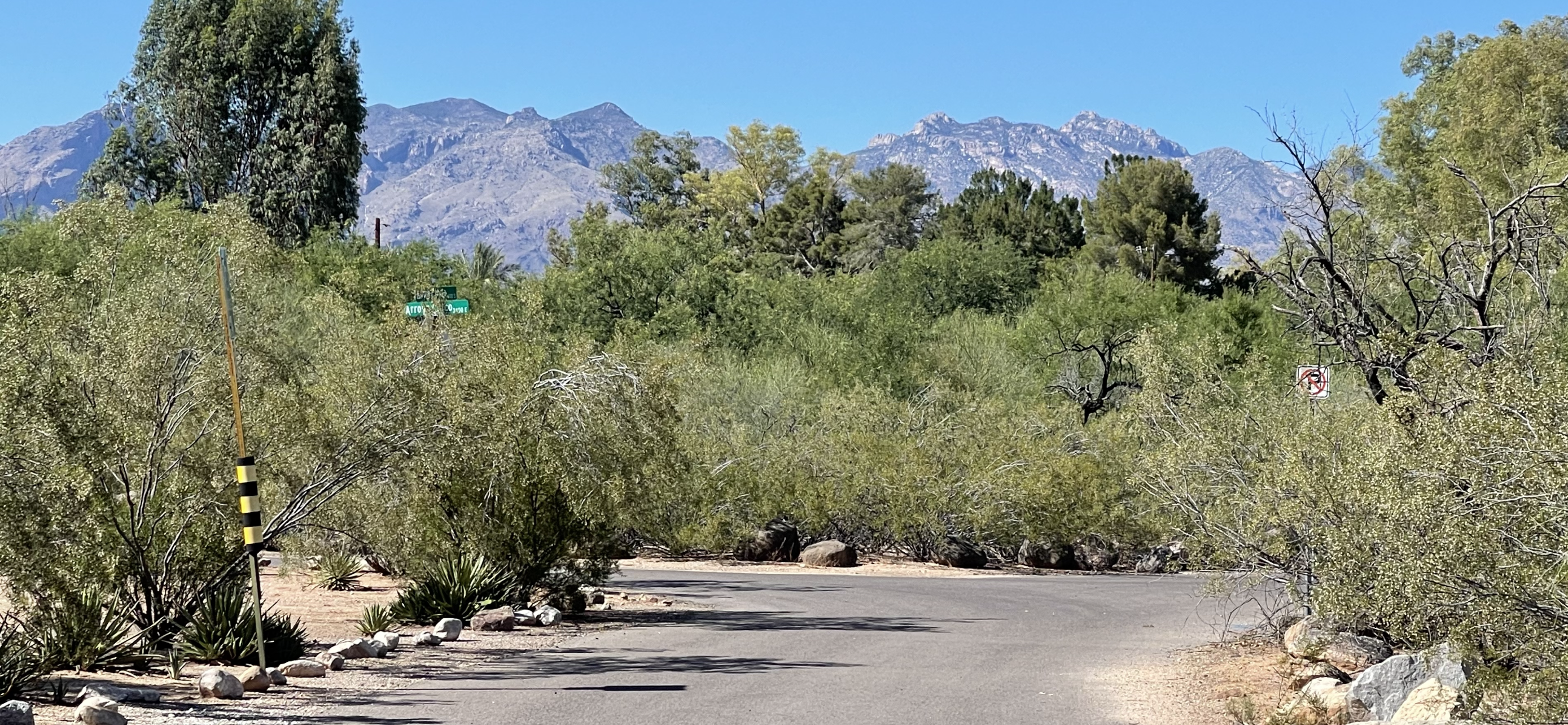
One thing is for sure, the western states (NM, AZ, WY, UT, CO, etc.) have some of the most magnificent mountain range views. While here in AZ, it seems these views are visible from seemingly every direction. Views like these certainly do not exist in FL, so I’m particularly aware and keenly vigilant to enjoy them while I’m in the area. I had a wonderful second week in Tucson, followed by a really enjoyable week in Apache Junction. So much to see and do in these areas, I could spend way more time here just to play tourist. But let’s review what I’ve been up to these past couple of weeks.
Tucson, AZ
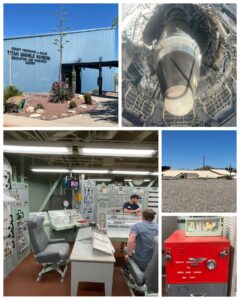 As I was exploring my resources to find interesting things to see in the area, I stumbled across the last remaining complete Titan II Missile facility, which has been turned into a museum. This facility was about 25 miles south of me in the area of Green Valley, and an easy drive down I-19. Visiting this only surviving Titan II silo was especially of interest to me. Back in the early 1960s, 54 of these Cold War, mutually assured destruction nuke sites were built – 18 each in three states – AZ, KS, and AR. I was stationed in Little Rock AFB AR back in late 1978 thru early 1980, which was home to the 308th Strategic Missile Wing who were responsible for the 18 missile sites located throughout AR. Though I was not directly in support of these sites, I certainly had a special interest in them being they were part of the base. Sadly, I was not in a position to have toured one of these silos during my assignment there in AR, so it was especially gratifying to me that I finally got to see one of these places up close and personal. It was a fascinating tour which included a trip down into the underground command center where we initiated a demo launch sequence, then off to the actual silo which contains an actual, albeit non-functional warhead-less, Titan II missile. During its prime, each missile carried a nine megaton nuclear warhead – three times the explosive power of all the bombs combined that were used during World War II, including both atomic bombs. So fortunate that they were never used. It was an absolutely fascinating tour and gave me a terrific view of life for the men and woman who supported the mission in these silos. As an aside, some of you older folks (like me) might recall the Titan II missile disaster that occurred in Damascus, AR in Sep of 1980. That event happened just a few short months after I had left AR for my next assignment to Yokota AB Japan. There is an outstanding documentary titled “Command and Control” that chronicles the events from that tragic accident that I would highly encourage folks to check out.
As I was exploring my resources to find interesting things to see in the area, I stumbled across the last remaining complete Titan II Missile facility, which has been turned into a museum. This facility was about 25 miles south of me in the area of Green Valley, and an easy drive down I-19. Visiting this only surviving Titan II silo was especially of interest to me. Back in the early 1960s, 54 of these Cold War, mutually assured destruction nuke sites were built – 18 each in three states – AZ, KS, and AR. I was stationed in Little Rock AFB AR back in late 1978 thru early 1980, which was home to the 308th Strategic Missile Wing who were responsible for the 18 missile sites located throughout AR. Though I was not directly in support of these sites, I certainly had a special interest in them being they were part of the base. Sadly, I was not in a position to have toured one of these silos during my assignment there in AR, so it was especially gratifying to me that I finally got to see one of these places up close and personal. It was a fascinating tour which included a trip down into the underground command center where we initiated a demo launch sequence, then off to the actual silo which contains an actual, albeit non-functional warhead-less, Titan II missile. During its prime, each missile carried a nine megaton nuclear warhead – three times the explosive power of all the bombs combined that were used during World War II, including both atomic bombs. So fortunate that they were never used. It was an absolutely fascinating tour and gave me a terrific view of life for the men and woman who supported the mission in these silos. As an aside, some of you older folks (like me) might recall the Titan II missile disaster that occurred in Damascus, AR in Sep of 1980. That event happened just a few short months after I had left AR for my next assignment to Yokota AB Japan. There is an outstanding documentary titled “Command and Control” that chronicles the events from that tragic accident that I would highly encourage folks to check out.
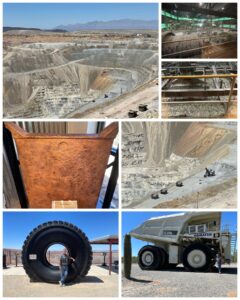 Next, I made a visit to a fully functioning copper mine. Little did I know that the US is the 5th largest producer of copper (Chile, Peru, Congo, and China are the other four), and AZ is the largest in the US – producing 65% of all US based copper. This was the Mission Mine that I visited – a 2.5 milea wide by 1.5 miles long by 1,200 feet deep open pit mine that operates 24 hours a day, 365 days a year (yes, even on holidays). This mine is one of three operational mines of ASARCO (American Smelting and Refining Company), producing upwards of 400,000,000 pounds of copper per year. From the visitor center, we took a van ride to the edge of the open pit mine. It was huge! Giant hauling trucks and mining shovels looked like ants from our vantage point. The wheels on a haul truck are 12 feet tall, cost $50,000 each, and have to be replaced about every six months. Wow! After the mine tour, we stopped in the mill where the rocks from the mine were pulverized into dust by crushing and tumbling them in large steel drums with 5-inch steel balls added. The dust is then mixed with water and special chemicals to produce a slurry. Air bubbles are added to the mixture and the copper material sticks to the bubbles and floats to the surface where it is skimmed off. A really fascinating process.
Next, I made a visit to a fully functioning copper mine. Little did I know that the US is the 5th largest producer of copper (Chile, Peru, Congo, and China are the other four), and AZ is the largest in the US – producing 65% of all US based copper. This was the Mission Mine that I visited – a 2.5 milea wide by 1.5 miles long by 1,200 feet deep open pit mine that operates 24 hours a day, 365 days a year (yes, even on holidays). This mine is one of three operational mines of ASARCO (American Smelting and Refining Company), producing upwards of 400,000,000 pounds of copper per year. From the visitor center, we took a van ride to the edge of the open pit mine. It was huge! Giant hauling trucks and mining shovels looked like ants from our vantage point. The wheels on a haul truck are 12 feet tall, cost $50,000 each, and have to be replaced about every six months. Wow! After the mine tour, we stopped in the mill where the rocks from the mine were pulverized into dust by crushing and tumbling them in large steel drums with 5-inch steel balls added. The dust is then mixed with water and special chemicals to produce a slurry. Air bubbles are added to the mixture and the copper material sticks to the bubbles and floats to the surface where it is skimmed off. A really fascinating process.
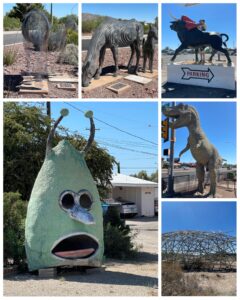 Next I visited a number of interesting Roadside America locations to see some strange art. First up were the Invisible Horses. Made in 2016 by Lauri Slenning, Ben Olmstead, and Simon Donovan, this piece stands in an otherwise empty median of a four-lane highway. As you approach the median from either direction, the piece is almost invisible (at left, top left), then the horses appear as you drive closer and as you pass by (left, top center). Really clever! Next was an anatomically complete bull and matador statue in a parking lot to a now closed restaurant. What makes this interesting is the specific anatomy that makes this a bull is painted in various flag designs throughout the year. Currently, it is boasting the flag of Italy. Very strange! Then there is the dinosaur at a local McDonalds. Not sure how or why he’s here, but it was kinda cool. Then there was the Goop – alien survivor of a once coveted mini-golf course. He was rescued from the defunct Magic Carpet mini-golf, and now sits at the corner of a residential neighborhood. Then there was the glowing cocoon – a 40 foot long walk-thru tunnel of scattered steel tubes that sits along the side of an otherwise busy highway. This was commissioned by the city of Tucson in 2014 by artist Blessing Hancock. It is said to be lit up at night – though some have stated the lights are no longer working. That’s ok as there was absolutely zero chance of me walking through that thing at night with all the snakes and scorpions in the area. No thank you!
Next I visited a number of interesting Roadside America locations to see some strange art. First up were the Invisible Horses. Made in 2016 by Lauri Slenning, Ben Olmstead, and Simon Donovan, this piece stands in an otherwise empty median of a four-lane highway. As you approach the median from either direction, the piece is almost invisible (at left, top left), then the horses appear as you drive closer and as you pass by (left, top center). Really clever! Next was an anatomically complete bull and matador statue in a parking lot to a now closed restaurant. What makes this interesting is the specific anatomy that makes this a bull is painted in various flag designs throughout the year. Currently, it is boasting the flag of Italy. Very strange! Then there is the dinosaur at a local McDonalds. Not sure how or why he’s here, but it was kinda cool. Then there was the Goop – alien survivor of a once coveted mini-golf course. He was rescued from the defunct Magic Carpet mini-golf, and now sits at the corner of a residential neighborhood. Then there was the glowing cocoon – a 40 foot long walk-thru tunnel of scattered steel tubes that sits along the side of an otherwise busy highway. This was commissioned by the city of Tucson in 2014 by artist Blessing Hancock. It is said to be lit up at night – though some have stated the lights are no longer working. That’s ok as there was absolutely zero chance of me walking through that thing at night with all the snakes and scorpions in the area. No thank you!
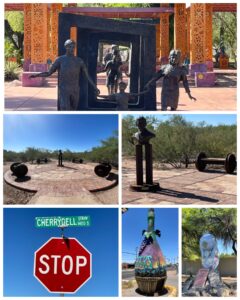 I continued my Roadside tour through Tucson and visited other interesting sites. At top right is a picture from the Cancer Survivors Plaza. Apparently, there are over a dozen similar pieces with bronze people walking through empty picture frames in several other cities across the country. Maybe I’m not artsy enough, but it’s an odd looking monument with an equally odd reference to surviving cancer. Next was a visit to a bronze head in an invisible train car. This bizarre piece is dedicated to Epes Randolph, an early Tucson railroad baron. He died in 1921, but it wasn’t until 2008 that this monument was unveiled. Yet another strange art piece. Next, a 9/11 Memorial (at right, bottom right) was built in 2002 by a group of local high school students. Nicely done! I then had to visit a giant 20-foot tall concrete wine bottle located at the Boondocks Lounge. Now that would give a giant hangover. Lastly, I found this particular road sign very interesting. Tucson is a city built on an orderly grid with North-South roads called Avenues, and East-West roads named Streets. But what of those roads that run diagonally? They are called Stravenues, or Strav for short. Cherrybell Stravenue was the first to be so named in 1949. It was the local Uniform Naming and Numbering Committee that agreed that a combination of Street and Avenue was the right way to go to complete their naming system. Today, there are 30 Stravenues in Tucson, but believed to be found nowhere else. And now you know the rest of that story!
I continued my Roadside tour through Tucson and visited other interesting sites. At top right is a picture from the Cancer Survivors Plaza. Apparently, there are over a dozen similar pieces with bronze people walking through empty picture frames in several other cities across the country. Maybe I’m not artsy enough, but it’s an odd looking monument with an equally odd reference to surviving cancer. Next was a visit to a bronze head in an invisible train car. This bizarre piece is dedicated to Epes Randolph, an early Tucson railroad baron. He died in 1921, but it wasn’t until 2008 that this monument was unveiled. Yet another strange art piece. Next, a 9/11 Memorial (at right, bottom right) was built in 2002 by a group of local high school students. Nicely done! I then had to visit a giant 20-foot tall concrete wine bottle located at the Boondocks Lounge. Now that would give a giant hangover. Lastly, I found this particular road sign very interesting. Tucson is a city built on an orderly grid with North-South roads called Avenues, and East-West roads named Streets. But what of those roads that run diagonally? They are called Stravenues, or Strav for short. Cherrybell Stravenue was the first to be so named in 1949. It was the local Uniform Naming and Numbering Committee that agreed that a combination of Street and Avenue was the right way to go to complete their naming system. Today, there are 30 Stravenues in Tucson, but believed to be found nowhere else. And now you know the rest of that story!
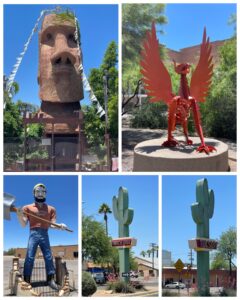 Lots of other Roadside goodies around town. Another rescue from the shuttered Magic Carpet Mini-Golf was this 25-ton Easter Island head replica. It now sits at the entrance to the Hut Nightclub. Very fitting! Then there’s Toby the red Griffin. He stands 12-feet tall sculpted out of metal in 2009, and is said to have been a survivor from a 1938 fire that destroyed the Carnegie Library, and its stone griffins. He sits across the street from where the library once stood, with footprints (half lion and half eagle) leading from its location. Really cool! A very tall fiberglass Muffler Man/Bunyan was stood up in 1964 to promote an auto shop. Today, his ax is seasonally replaced with a giant candy cane, and sometimes he is dressed as Santa. Last in this group is the 30-food tall Neon Cactus. This was built in 2010 and stands in the middle of Oracle Rd – also known as the Miracle Mile. This road was the first divided highway in Arizona, and was called the Miracle Mile of Safety when it opened in 1937. One side of the cactus reads Tuscon, and the other Miracle Mile. It is reportedly covered in neon lights and looks really good at night all lit up. But alas my visit was during the day.
Lots of other Roadside goodies around town. Another rescue from the shuttered Magic Carpet Mini-Golf was this 25-ton Easter Island head replica. It now sits at the entrance to the Hut Nightclub. Very fitting! Then there’s Toby the red Griffin. He stands 12-feet tall sculpted out of metal in 2009, and is said to have been a survivor from a 1938 fire that destroyed the Carnegie Library, and its stone griffins. He sits across the street from where the library once stood, with footprints (half lion and half eagle) leading from its location. Really cool! A very tall fiberglass Muffler Man/Bunyan was stood up in 1964 to promote an auto shop. Today, his ax is seasonally replaced with a giant candy cane, and sometimes he is dressed as Santa. Last in this group is the 30-food tall Neon Cactus. This was built in 2010 and stands in the middle of Oracle Rd – also known as the Miracle Mile. This road was the first divided highway in Arizona, and was called the Miracle Mile of Safety when it opened in 1937. One side of the cactus reads Tuscon, and the other Miracle Mile. It is reportedly covered in neon lights and looks really good at night all lit up. But alas my visit was during the day.
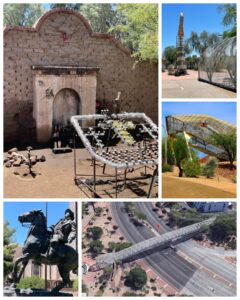 Last up in the Tucson Roadside tour are these gems. Believed to be the only Catholic shrine in the US dedicated to a sinner instead of a saint, the El Tiradito Shrine has been at this location for over 100 years. The story goes a young married ranch hand had an affair with an older woman – his mother-in-law. He was caught in the act and allegedly axed to death on the spot by the husband – his own father-in-law. Given the nature of his sin, he was unable to be buried in consecrated ground. So, they buried him near where he was killed. Soon thereafter, a shrine sprung up in his memory, with candles lit and letters left to request he be forgiven. Today, El Tiradito (the little castaway) is a place to light a candle and to make a wish. It is said if the candle burns through the night, your wish will be granted. Next up was a visit to Rattlesnake Bridge. This pedestrian/bike bridge resembles a diamondback rattlesnake, with large fangs on the head on one end, a rattler tail on the other end, and a diamond back body that spans across the road. I included a couple of pictures I had not taken, including the head and an overall aerial view, so you could get a sense of this really cool bridge. I only visited and got pictures of the tail. Last up is this statue of Pancho Villa which stands in a little park in downtown Tucson. It was a gift from the Mexican government in 1981 but today is somewhat controversial as Pancho killed many Americans back in the early 1900s with his many invasions. Geez – who would have thought – a controversial statue!
Last up in the Tucson Roadside tour are these gems. Believed to be the only Catholic shrine in the US dedicated to a sinner instead of a saint, the El Tiradito Shrine has been at this location for over 100 years. The story goes a young married ranch hand had an affair with an older woman – his mother-in-law. He was caught in the act and allegedly axed to death on the spot by the husband – his own father-in-law. Given the nature of his sin, he was unable to be buried in consecrated ground. So, they buried him near where he was killed. Soon thereafter, a shrine sprung up in his memory, with candles lit and letters left to request he be forgiven. Today, El Tiradito (the little castaway) is a place to light a candle and to make a wish. It is said if the candle burns through the night, your wish will be granted. Next up was a visit to Rattlesnake Bridge. This pedestrian/bike bridge resembles a diamondback rattlesnake, with large fangs on the head on one end, a rattler tail on the other end, and a diamond back body that spans across the road. I included a couple of pictures I had not taken, including the head and an overall aerial view, so you could get a sense of this really cool bridge. I only visited and got pictures of the tail. Last up is this statue of Pancho Villa which stands in a little park in downtown Tucson. It was a gift from the Mexican government in 1981 but today is somewhat controversial as Pancho killed many Americans back in the early 1900s with his many invasions. Geez – who would have thought – a controversial statue!
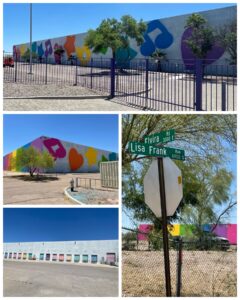 If any of you had little girls in the 7-13 range in the 80s and 90s (like I did), you would certainly be familiar with products from a company called Lisa Frank. Sparkly items such as stickers and school supplies with rainbows, unicorns, and the like, won the hearts of many children and tweens back during that time. It was founded in 1979, headquartered here in Tucson, and named after its 24-year old founder. It grew rapidly – so much so that in 1996, this 320,000 square-foot factory was built and opened. They even named one of the streets that runs along one side of the building as Lisa Frank Ave. With its rainbow loading docks and other colorful artsy facade, this once thriving business now stands idle after the decline in sales as the bulk of their target audience has since grown up. Today, vintage Lisa Frank products have seemingly gotten a resurgence in popularity, so who knows – maybe they will fire up this factory once again. Definitely a cool looking building with an interesting history.
If any of you had little girls in the 7-13 range in the 80s and 90s (like I did), you would certainly be familiar with products from a company called Lisa Frank. Sparkly items such as stickers and school supplies with rainbows, unicorns, and the like, won the hearts of many children and tweens back during that time. It was founded in 1979, headquartered here in Tucson, and named after its 24-year old founder. It grew rapidly – so much so that in 1996, this 320,000 square-foot factory was built and opened. They even named one of the streets that runs along one side of the building as Lisa Frank Ave. With its rainbow loading docks and other colorful artsy facade, this once thriving business now stands idle after the decline in sales as the bulk of their target audience has since grown up. Today, vintage Lisa Frank products have seemingly gotten a resurgence in popularity, so who knows – maybe they will fire up this factory once again. Definitely a cool looking building with an interesting history.
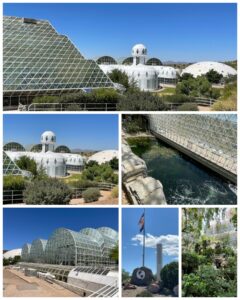 The last big adventure I took in Tucson was to drive out about an hour north to take a tour of a place called Biosphere 2. This earth system science research facility is located in the Sonoran Desert in Oracle, AZ. It’s just over 3 acres of glass structure designed to be a closed ecological system, and remains the largest one ever created. Built between 1987 and 1991, it was originally meant to demonstrate viability of a closed system to support and maintain human life in, for example, outer space (e.g. Mars). Besides living accommodations (bedrooms, kitchen, gym, etc.), laboratories and workshops, its large under-glass habitat contains five large biome areas. These include a rainforest, an ocean with a coral reef, mangrove wetlands, Savannah grassland, and a fog desert. There were two attempts to live in the Biosphere, once in 1991 with 8 people spending two years inside, and again in 1994 with a 6 month stint among a crew of 7. Neither mission were total successes, as both oxygen and food shortages occurred, while the second mission was filled with lots of personal drama. Biosphere went into receivership, police were called, and locks were changed. The facility had undergone several changes of ownership over the ensuing years, and was even almost ready to have been torn down. In 2007, the University of Arizona took over the facility and have owned and managed it ever since. It was a great tour, self guided with the help of a phone app with video segments at various stations throughout the tour. Today, it is used exclusively as a research facility, with a particular focus on climate change. Really interesting place! A documentary titled “Spaceship Earth” was released in 2020 which chronicles the story of Biosphere 2. Check it out!
The last big adventure I took in Tucson was to drive out about an hour north to take a tour of a place called Biosphere 2. This earth system science research facility is located in the Sonoran Desert in Oracle, AZ. It’s just over 3 acres of glass structure designed to be a closed ecological system, and remains the largest one ever created. Built between 1987 and 1991, it was originally meant to demonstrate viability of a closed system to support and maintain human life in, for example, outer space (e.g. Mars). Besides living accommodations (bedrooms, kitchen, gym, etc.), laboratories and workshops, its large under-glass habitat contains five large biome areas. These include a rainforest, an ocean with a coral reef, mangrove wetlands, Savannah grassland, and a fog desert. There were two attempts to live in the Biosphere, once in 1991 with 8 people spending two years inside, and again in 1994 with a 6 month stint among a crew of 7. Neither mission were total successes, as both oxygen and food shortages occurred, while the second mission was filled with lots of personal drama. Biosphere went into receivership, police were called, and locks were changed. The facility had undergone several changes of ownership over the ensuing years, and was even almost ready to have been torn down. In 2007, the University of Arizona took over the facility and have owned and managed it ever since. It was a great tour, self guided with the help of a phone app with video segments at various stations throughout the tour. Today, it is used exclusively as a research facility, with a particular focus on climate change. Really interesting place! A documentary titled “Spaceship Earth” was released in 2020 which chronicles the story of Biosphere 2. Check it out!
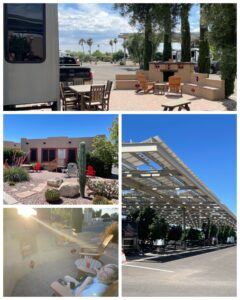 I wrapped up my time here in Tucson with a dinner at the RV with my dear friend Helen. It really was wonderful seeing her again, and despite my having ruined the steaks by overcooking them on the grill, we still managed to enjoy a wonderful evening together complete with a fire in the included RV site fireplace. We topped off the night with some freshly made S’mores for dessert. Kinda made up for the overcooked steaks. I so enjoyed catching up with Helen, and I appreciate her coming out to the RV for dinner. I was fortunate to have a really nice deluxe RV site in what was an absolutely beautiful KOA campground Many of the sites featured one-off custom built fireplaces, some even had private dog parks. There were large solar structures that provided the campground with free energy, while also providing shade to those RVs parked in the sites beneath them. Even their camping cabins had a southwest flare to them. This was an absolutely amazing campground and has definitely made my top three destinations list. I look forward to coming back here again sometime it the future.
I wrapped up my time here in Tucson with a dinner at the RV with my dear friend Helen. It really was wonderful seeing her again, and despite my having ruined the steaks by overcooking them on the grill, we still managed to enjoy a wonderful evening together complete with a fire in the included RV site fireplace. We topped off the night with some freshly made S’mores for dessert. Kinda made up for the overcooked steaks. I so enjoyed catching up with Helen, and I appreciate her coming out to the RV for dinner. I was fortunate to have a really nice deluxe RV site in what was an absolutely beautiful KOA campground Many of the sites featured one-off custom built fireplaces, some even had private dog parks. There were large solar structures that provided the campground with free energy, while also providing shade to those RVs parked in the sites beneath them. Even their camping cabins had a southwest flare to them. This was an absolutely amazing campground and has definitely made my top three destinations list. I look forward to coming back here again sometime it the future.
Apache Junction, AZ
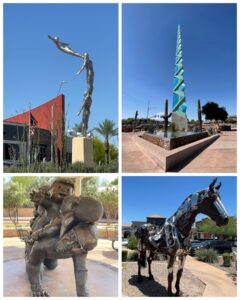 My next stop would take me about two hours north to Apache Junction. Located about fourty miles west of Phoenix, it was a great location to visit other nearby towns such as Tempe, Scottsdale, Fountain Hills, and Mesa. There were tons of things to see and do in these smaller, simpler towns, which allowed me to stay out of the big city of Phoenix. There was lots of artwork to be seen around these area. For example this beautiful sculpture piece titled Aspire (at right, top left) was installed in 2014 in the center of a roundabout in Scottsdale. Also in Scottsdale is the Frank Lloyd Wright Spire. It was designed in 1957 by Wright himself for the town of Phoenix. They rejected it, but in 2004, it found its way here in Scottsdale as a focal point in a shopping and restaurant plaza. It is 125 feet tall, weighs in at a whopping 75,000 pounds, and is assembled with around 1,700 individual pieces of steel. Pretty cool! You might recognize the last piece I saw in Scottsdale. Called “Giddy-Up Daddy”, this life size dad is providing a piggy-back ride to his kids – Billy, Dolly, Jeffry, and P.J. Of course the dad is Bil Keene of Family Circus comic strip fame. He moved from Philly to Scottsdale in 1958 and was a staff artist for the local newspaper. The Family Circus comic was first published in Scottsdale, and by 1960, was syndicated to hundreds of newspapers and the rest is history. Unveiled in 2013, this statue was sculpted by artist Debbie Gessner. The design was done by Bil’s son Jeff (who continues to create the Family Circus comic) based on a miniature ceramic sculpture made by Bil in the 1980s. It was really cool! Next, I took a drive to the town of Fountain Hills. There I would find this horse made out of junk. Kitchen utensils, appliances, and car parts are just some of the contents that make up this art piece. It’s located in the middle of a shopping complex parking lot.
My next stop would take me about two hours north to Apache Junction. Located about fourty miles west of Phoenix, it was a great location to visit other nearby towns such as Tempe, Scottsdale, Fountain Hills, and Mesa. There were tons of things to see and do in these smaller, simpler towns, which allowed me to stay out of the big city of Phoenix. There was lots of artwork to be seen around these area. For example this beautiful sculpture piece titled Aspire (at right, top left) was installed in 2014 in the center of a roundabout in Scottsdale. Also in Scottsdale is the Frank Lloyd Wright Spire. It was designed in 1957 by Wright himself for the town of Phoenix. They rejected it, but in 2004, it found its way here in Scottsdale as a focal point in a shopping and restaurant plaza. It is 125 feet tall, weighs in at a whopping 75,000 pounds, and is assembled with around 1,700 individual pieces of steel. Pretty cool! You might recognize the last piece I saw in Scottsdale. Called “Giddy-Up Daddy”, this life size dad is providing a piggy-back ride to his kids – Billy, Dolly, Jeffry, and P.J. Of course the dad is Bil Keene of Family Circus comic strip fame. He moved from Philly to Scottsdale in 1958 and was a staff artist for the local newspaper. The Family Circus comic was first published in Scottsdale, and by 1960, was syndicated to hundreds of newspapers and the rest is history. Unveiled in 2013, this statue was sculpted by artist Debbie Gessner. The design was done by Bil’s son Jeff (who continues to create the Family Circus comic) based on a miniature ceramic sculpture made by Bil in the 1980s. It was really cool! Next, I took a drive to the town of Fountain Hills. There I would find this horse made out of junk. Kitchen utensils, appliances, and car parts are just some of the contents that make up this art piece. It’s located in the middle of a shopping complex parking lot.
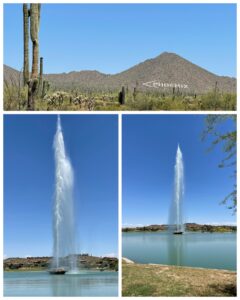 While on the subject of Fountain Hills, AZ, besides it being one of the most attractive towns I’ve seen in the southwest, it has several claims to fame. Most notably, as the town name suggests, it has a fountain. But not just any fountain, it’s the fourth tallest fountain in the world – second tallest in the US. When it was built in 1970, it was the worlds tallest, a record it held for over a decade. Using three 600 hp pumps, it sprays water at 7,000 gal per minute through an 18-inch nozzle achieving its record holding height of 560 feet. It only runs for 15 minutes at the top of each hour, which of course I had to stick around to see. And what a sight to see – it was magnificent! I’ve not seen anything like it. Definitely worth the visit. I captured a short video of the fountain which you can check out below. On the way to that town, I drove by an obscure Roadside item known as the Phoenix Arrow. It’s 1,000 feet long and 100 feet tall, this giant arrow and the word Phoenix was created using arranged white painted rocks, and was created by the Boy Scouts in the early 1950s. They were given a project to create a marker that would aid pilots in directing them to the Phoenix airport, some 20 miles to the east. They collected rocks from the mountainside, then placed them strategically to form the 100 feet tall, 12 feet wide letters. They then added the arrow. It took them 5 1/2 years to complete the project. Current scout troops maintain the sign, including the use of over 425 gallons of paint to freshen and brighten up the rocks in 2010. Just too cool!
While on the subject of Fountain Hills, AZ, besides it being one of the most attractive towns I’ve seen in the southwest, it has several claims to fame. Most notably, as the town name suggests, it has a fountain. But not just any fountain, it’s the fourth tallest fountain in the world – second tallest in the US. When it was built in 1970, it was the worlds tallest, a record it held for over a decade. Using three 600 hp pumps, it sprays water at 7,000 gal per minute through an 18-inch nozzle achieving its record holding height of 560 feet. It only runs for 15 minutes at the top of each hour, which of course I had to stick around to see. And what a sight to see – it was magnificent! I’ve not seen anything like it. Definitely worth the visit. I captured a short video of the fountain which you can check out below. On the way to that town, I drove by an obscure Roadside item known as the Phoenix Arrow. It’s 1,000 feet long and 100 feet tall, this giant arrow and the word Phoenix was created using arranged white painted rocks, and was created by the Boy Scouts in the early 1950s. They were given a project to create a marker that would aid pilots in directing them to the Phoenix airport, some 20 miles to the east. They collected rocks from the mountainside, then placed them strategically to form the 100 feet tall, 12 feet wide letters. They then added the arrow. It took them 5 1/2 years to complete the project. Current scout troops maintain the sign, including the use of over 425 gallons of paint to freshen and brighten up the rocks in 2010. Just too cool!
The other claim to fame for Fountain Hills is that it has the most city art of any city in AZ. There was art everywhere. I could easily have spent an entire day there just darting around the town and viewing all the sculptures and statues. In their Veterans Park, they had several statues including one depicting an elderly man standing with a cane, in the uniform he wore in his youth, saluting the flag. It was really moving, and an excellent piece for a veterans park. Further down the road, but also along the shores of the fountain lake was Fount Rushmore. A play on Mount Rushmore, this area had statues of the four presidents represented on Mount Rushmore, in addition to having Presidents FDR and Ronald Reagan. It was a cool little park with some really nicely done statues. I would have loved to spend more time in this town, but alas I had an important appointment later in the afternoon that I could not miss (more on that below).
So, what was that appointment that was so important I could not miss it? Well, it was to get a tour of Alcor – one of the few cryonics facilities in the country. Believe it or not, it was Roadside America that had this tour as one of their must see entries, and I was purplexed as to why an operational cryogenics place would do tours. So, I checked out their website, and sure enough, they did tours every Friday afternoon. So I signed up for the next day. I have to admit, the geek in me was really intrigued about this entire industry, but another part of me was a bit creeped out by it. The tour was amazing, and I left feeling really good about the company and their offerings (though I was not yet ready to sign up myself). The company is actually a non-profit, and besides providing the after-death freezing and storage of bodies and parts, they also do a lot of research related to human physiology that will one day help in many areas such as prolonging the useful life of organs for transplant, or even various processes that can be used for injured soldiers in battle to lengthen the time they have to get to a hospital for ultimate care. Their tour guides were notably passionate about their work.
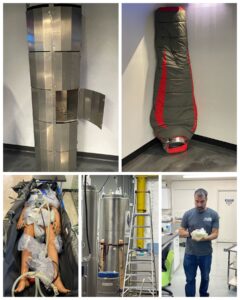 So now the squeamish stuff. When one of their subscribers dies, they are there immediately to start the preservation and cooling down process. That begins with introducing special fluids (liquid gold as they called it) (pictured at left, bottom right) to replace the blood. This acts as sort of an anti-freeze to keep the blood from crystallizing during the freezing process and to preserve the organs. They put a thumper on the chest of the deceased to sort of perform CPR to keep the heart beating so as to maintain circulation during this fluid entry process. A ventilator is also used to keep the body oxygenated. Ice is initially introduced around the body to begin the cooling process – which is actually a very slow and methodical endeavor. When all the body prep work is complete, they are then entered into a chamber (pictured left, center bottom) where their temperature is dropped by about 1 degree per hour, until it reaches the liquid nitrogen
So now the squeamish stuff. When one of their subscribers dies, they are there immediately to start the preservation and cooling down process. That begins with introducing special fluids (liquid gold as they called it) (pictured at left, bottom right) to replace the blood. This acts as sort of an anti-freeze to keep the blood from crystallizing during the freezing process and to preserve the organs. They put a thumper on the chest of the deceased to sort of perform CPR to keep the heart beating so as to maintain circulation during this fluid entry process. A ventilator is also used to keep the body oxygenated. Ice is initially introduced around the body to begin the cooling process – which is actually a very slow and methodical endeavor. When all the body prep work is complete, they are then entered into a chamber (pictured left, center bottom) where their temperature is dropped by about 1 degree per hour, until it reaches the liquid nitrogen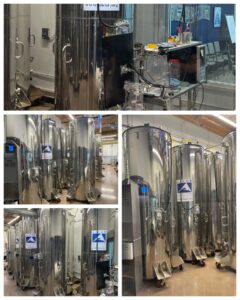 temp of around -196 degrees – usually in 5 to 7 days. Once they have become a corpcicle (my term, not theirs), they are then placed in a stainless dewer for their long-term stay. Each of the dewers pictured here at right can hold four full-body patients, and up to ten neuro (head only) patients. Full bodied customers are placed head down in a sort of sleeping bag (at left, top right) into the edges of the dewer, while neuro customers are stored in a rack like structure (pictured left, top left) located down the center. All are then maintained in their frozen state using the liquid nitrogen. Just over 200 patients are currently in cryogenic storage (pictured right) – about 70/30 between neuro and full body.
temp of around -196 degrees – usually in 5 to 7 days. Once they have become a corpcicle (my term, not theirs), they are then placed in a stainless dewer for their long-term stay. Each of the dewers pictured here at right can hold four full-body patients, and up to ten neuro (head only) patients. Full bodied customers are placed head down in a sort of sleeping bag (at left, top right) into the edges of the dewer, while neuro customers are stored in a rack like structure (pictured left, top left) located down the center. All are then maintained in their frozen state using the liquid nitrogen. Just over 200 patients are currently in cryogenic storage (pictured right) – about 70/30 between neuro and full body.
Well, if you’ve gotten this far in the story, you’ve not yet been weirded out. Cryogenics is certainly a controversial practice, but I have to say that while I won’t be a customer, I was certainly overall impressed by the company, their delicate handling of the subject, and the vigor they expressed in their desire to achieve outside medical benefits by using the technologies and lessons learned from their practice. So how is this payed for? Simple – full-body customers take out a $250K ($80K for neuro) insurance policy with Alcor as the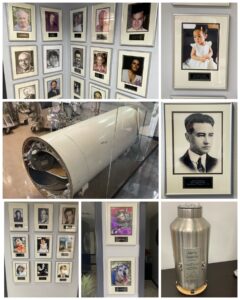 beneficiary. At time of death, approximately $130K ($35K for neuro) of that comes off the top and is handed over to a separate arm of the company that puts the money in trust. It is conservatively managed and invested and whose proceeds are used to fund the costs for possible centuries of cryonic storage. The other funds are used to cover the costs to prep and freeze the newly deceased customer. I was also touched by the personal elements of the company. The walls are filled with pictures of their stored patients – human and animal alike (yea, there are several pets stored here too). They said some family members send cards and letters which they keep in a box for each patient, while others even come to visit their lost loved ones. The oldest person at time of cryonic storage was a 102 year old woman, and the youngest was a young girl from China just shy of her third birthday (pictured left, top right). The person that has been in a cryonic state the longest is James Bedford (pictured left, center right) – born 1883, died in 1967. He was a psychology professor at the University of California, and had developed kidney cancer which later metastasized into his lungs. There was no treatment at the time, so it was his desire to be cryogenically frozen in hopes that he can be revived and his cancer treated sometime in the future. He was the first person whose body was cryopreserved after his death. After him bouncing around several cryo facilities in the early years, his family actually cared for him from 1977 thru 1982, when he was moved to Alcor’s care where he remains to this day. His original, yet crude cryogenic container (pictured at left, center left) served him well for the decade and half. Alcor moved him to one of their more state of the art dewers at the time where he remains today. For the neuro customers, once the head is separated from the body, the body part is cremated with the ashes placed into a container shaped like a dewer and given to the family. Apparently, Jerry Searcy who died in 2019 had no family, so his body ashes (at left, bottom right) are kept there at the Alcor facility.
beneficiary. At time of death, approximately $130K ($35K for neuro) of that comes off the top and is handed over to a separate arm of the company that puts the money in trust. It is conservatively managed and invested and whose proceeds are used to fund the costs for possible centuries of cryonic storage. The other funds are used to cover the costs to prep and freeze the newly deceased customer. I was also touched by the personal elements of the company. The walls are filled with pictures of their stored patients – human and animal alike (yea, there are several pets stored here too). They said some family members send cards and letters which they keep in a box for each patient, while others even come to visit their lost loved ones. The oldest person at time of cryonic storage was a 102 year old woman, and the youngest was a young girl from China just shy of her third birthday (pictured left, top right). The person that has been in a cryonic state the longest is James Bedford (pictured left, center right) – born 1883, died in 1967. He was a psychology professor at the University of California, and had developed kidney cancer which later metastasized into his lungs. There was no treatment at the time, so it was his desire to be cryogenically frozen in hopes that he can be revived and his cancer treated sometime in the future. He was the first person whose body was cryopreserved after his death. After him bouncing around several cryo facilities in the early years, his family actually cared for him from 1977 thru 1982, when he was moved to Alcor’s care where he remains to this day. His original, yet crude cryogenic container (pictured at left, center left) served him well for the decade and half. Alcor moved him to one of their more state of the art dewers at the time where he remains today. For the neuro customers, once the head is separated from the body, the body part is cremated with the ashes placed into a container shaped like a dewer and given to the family. Apparently, Jerry Searcy who died in 2019 had no family, so his body ashes (at left, bottom right) are kept there at the Alcor facility.
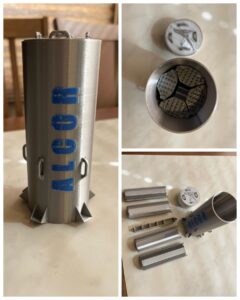 One last closing thought from this tour, and to my sister-in-law Debbie, a huge baseball fan, this is for you! While most of the patients are relatively unknowns, there are a few more notable folks stored here. Most notable among them would be famed Boston Red Sox left fielder Ted Williams. He, along with his son and daughter signed a pact whereby they would remain together in cryogenic storage on the off chance that they would one day be reunited together. Ted’s son John Henry Williams was diagnosed with leukemia and died in 2004 at the age of 35, and has joined his dad in the Alcor facility. Interestingly, both are neuro (head) patients only. I would imagine his daughter will join them someday upon her death. This remains a fringe after-life service. Alcor has about 1,400 signed up customers for future cryonic storage. Interestingly, it’s about an 80/20 split between men vs woman customers, and their average age is in the mid 30’s. They are obviously doing continued marketing and public relations to increase their customer base, including doing these weekly facility tours. In case you are interested, CNET did a nice video story on Alcor a couple years ago, and you can watch it HERE on YouTube. I left the tour feeling rather good about this whole thing overall, but despite the marketing materials and 3-d printed toy dewer souvenir that was included in the exit package (pictured at right), it’s doubtful that I’ll be a customer. But I do appreciate their mission, and respect those that choose to bet on a future that may include being brought back to life. I wish them well! As for me, I think I’d rather subscribe to a service that more closely resembles the afterlife depicted in the hit Prime Video series “Upload”. That certainly looks way more my style!
One last closing thought from this tour, and to my sister-in-law Debbie, a huge baseball fan, this is for you! While most of the patients are relatively unknowns, there are a few more notable folks stored here. Most notable among them would be famed Boston Red Sox left fielder Ted Williams. He, along with his son and daughter signed a pact whereby they would remain together in cryogenic storage on the off chance that they would one day be reunited together. Ted’s son John Henry Williams was diagnosed with leukemia and died in 2004 at the age of 35, and has joined his dad in the Alcor facility. Interestingly, both are neuro (head) patients only. I would imagine his daughter will join them someday upon her death. This remains a fringe after-life service. Alcor has about 1,400 signed up customers for future cryonic storage. Interestingly, it’s about an 80/20 split between men vs woman customers, and their average age is in the mid 30’s. They are obviously doing continued marketing and public relations to increase their customer base, including doing these weekly facility tours. In case you are interested, CNET did a nice video story on Alcor a couple years ago, and you can watch it HERE on YouTube. I left the tour feeling rather good about this whole thing overall, but despite the marketing materials and 3-d printed toy dewer souvenir that was included in the exit package (pictured at right), it’s doubtful that I’ll be a customer. But I do appreciate their mission, and respect those that choose to bet on a future that may include being brought back to life. I wish them well! As for me, I think I’d rather subscribe to a service that more closely resembles the afterlife depicted in the hit Prime Video series “Upload”. That certainly looks way more my style!
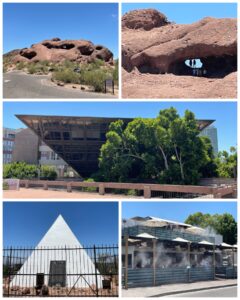 So, after the trauma that was the Alcor visit, the next day I did some touring around Tempe and Mesa. My first stop was to Papago Park, technically in the far eastern portion of Phoenix, but just north of Tempe. There I found a place called the Hole-in-the-Rock (pictured left, top). This sandstone desert butte was subject to natural erosion which created this large hole in he center. It’s a popular hiking spot for locals to climb to get up to the hole. I enjoyed the views from ground thank you. Also in Papago Park is Governor Hunt’s Pyramid Tomb. Set upon a tall hill in the park, George W.P. Hunt (born 1859, died 1934), his wife, his in-laws, and his daughter all share this resting spot with a view. George Hunt was Arizona’s 1st governor, and in fact was also its 2nd, 3rd, 6th, 7th, 8th and 10th – making him the national record holder for the number of times to hold the governors office. That’s pretty impressive! Then in downtown Tempe, I visited the town’s City Hall – an upside down pyramid. The interesting feature of this design, built in 1970, is that for each of the windows along the six stories, each are naturally shaded. Good thing cause it’s definitely hot here in the summer! Speaking of which, as I was driving through downtown Tempe, I happened upon this bar/restaurant that had outdoor seating. It was 100 degrees on this day, and like many other venues, this place used misters to keep its patrons cool. Cool indeed!
So, after the trauma that was the Alcor visit, the next day I did some touring around Tempe and Mesa. My first stop was to Papago Park, technically in the far eastern portion of Phoenix, but just north of Tempe. There I found a place called the Hole-in-the-Rock (pictured left, top). This sandstone desert butte was subject to natural erosion which created this large hole in he center. It’s a popular hiking spot for locals to climb to get up to the hole. I enjoyed the views from ground thank you. Also in Papago Park is Governor Hunt’s Pyramid Tomb. Set upon a tall hill in the park, George W.P. Hunt (born 1859, died 1934), his wife, his in-laws, and his daughter all share this resting spot with a view. George Hunt was Arizona’s 1st governor, and in fact was also its 2nd, 3rd, 6th, 7th, 8th and 10th – making him the national record holder for the number of times to hold the governors office. That’s pretty impressive! Then in downtown Tempe, I visited the town’s City Hall – an upside down pyramid. The interesting feature of this design, built in 1970, is that for each of the windows along the six stories, each are naturally shaded. Good thing cause it’s definitely hot here in the summer! Speaking of which, as I was driving through downtown Tempe, I happened upon this bar/restaurant that had outdoor seating. It was 100 degrees on this day, and like many other venues, this place used misters to keep its patrons cool. Cool indeed!
 Next, I visited a couple of gravesites. Located in the Mesa City Cemetery, I first paid my respects to the grave of Ernesto A Miranda. Now, before reading any further, stop and think a second about how this person might have made history. Ok, now that you’ve guessed, did you come up with the theory of him being responsible for the establishment of Miranda Rights? You know, the right to remain silent … the right to an attorney, etc. If that is where you went, you would be correct. Ernesto was a career criminal, and in 1963, was arrested for armed robbery, kidnapping and the rape of an 18-year old girl. Law enforcement failed to advise him of his rights, and back then, lawyers for indigent defendants were not automatically assigned. He confessed and was convicted of these crimes. His attorney appealed, which led to the 1966 U.S. Supreme Court ruling that we all enjoy today. He won his appeal and was released. However, he was immediately rearrested, tried for the same crimes but this time not including his original confession, and was found guilty and sent back to prison. He was paroled in 1972, and with his new found fame, hung around selling souvenir “Miranda Warning” cards on the streets of Phoenix. In 1976, he got involved in a Phoenix skid-row bar brawl and was stabbed to death. What an interesting story! Also in that same cemetery was the grave of country music legend Waylon Jennings. He was born in TX, but relocated to Chandler, AZ during his drug addiction years in an attempt to get clean. Between the drugs, smoking, and Type II Diabetes, he succumbed to all his ailments in 2002 and was buried here in Mesa. Next up was this Roadside gem – a 70 feet tall neon piece of a blonde girl diving in perpetual motion into the water. It was created in 1960 as an attraction piece for the Starlite Motel. In 2010 a wind storm knocked down the sign, destroyed all the neon tubes, and severely mangled the metal parts. It looked like it was the end of the diver, but local fans raised $125K, and in 2013, she was rebuilt and restored. I’ll bet that’s a sight to see in the evening in motion. Want to see? My brother found this video of it on YouTube HERE. Last up in this collage is the Lost Dutchman Monument from Apache Junction. It was built in 1938 to honor Jacob Waltz, a German immigrant Dutchman and prospector who after a 20 year search reportedly discovered a gold mine in the nearby Superstition Mountains. Sadly, he never revealed its location before his death in 1891. People have been looking for it ever since.
Next, I visited a couple of gravesites. Located in the Mesa City Cemetery, I first paid my respects to the grave of Ernesto A Miranda. Now, before reading any further, stop and think a second about how this person might have made history. Ok, now that you’ve guessed, did you come up with the theory of him being responsible for the establishment of Miranda Rights? You know, the right to remain silent … the right to an attorney, etc. If that is where you went, you would be correct. Ernesto was a career criminal, and in 1963, was arrested for armed robbery, kidnapping and the rape of an 18-year old girl. Law enforcement failed to advise him of his rights, and back then, lawyers for indigent defendants were not automatically assigned. He confessed and was convicted of these crimes. His attorney appealed, which led to the 1966 U.S. Supreme Court ruling that we all enjoy today. He won his appeal and was released. However, he was immediately rearrested, tried for the same crimes but this time not including his original confession, and was found guilty and sent back to prison. He was paroled in 1972, and with his new found fame, hung around selling souvenir “Miranda Warning” cards on the streets of Phoenix. In 1976, he got involved in a Phoenix skid-row bar brawl and was stabbed to death. What an interesting story! Also in that same cemetery was the grave of country music legend Waylon Jennings. He was born in TX, but relocated to Chandler, AZ during his drug addiction years in an attempt to get clean. Between the drugs, smoking, and Type II Diabetes, he succumbed to all his ailments in 2002 and was buried here in Mesa. Next up was this Roadside gem – a 70 feet tall neon piece of a blonde girl diving in perpetual motion into the water. It was created in 1960 as an attraction piece for the Starlite Motel. In 2010 a wind storm knocked down the sign, destroyed all the neon tubes, and severely mangled the metal parts. It looked like it was the end of the diver, but local fans raised $125K, and in 2013, she was rebuilt and restored. I’ll bet that’s a sight to see in the evening in motion. Want to see? My brother found this video of it on YouTube HERE. Last up in this collage is the Lost Dutchman Monument from Apache Junction. It was built in 1938 to honor Jacob Waltz, a German immigrant Dutchman and prospector who after a 20 year search reportedly discovered a gold mine in the nearby Superstition Mountains. Sadly, he never revealed its location before his death in 1891. People have been looking for it ever since.
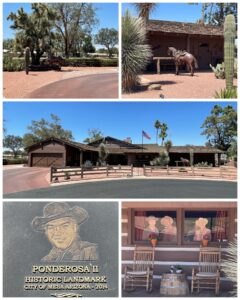 Here’s another interesting Roadside find. Known as the Bonanza Ranch House, this was built in the early 1960s by Bonanza star Lorne Greene (Ben Cartwright) as a replica of the TV series ranch house. Lorne actually lived in the home part time for a few years, then sold it. That owner passed away and today, it remains a private residence owned by the Swans – lifelong Bonanza fans who were quoted as saying “This is the holy grail of ‘Bonanza’ collectibles”. They have not only restored it from the changes made by the previous owner, but have also gotten the city of Mesa to designate it a historical landmark thus preserving its future. Supposedly, even the main room inside the house was modeled after the shows set house located in Paramount Studios and even reportedly contains artifacts from the original set acquired when the show ended. A hitching post and a couple fiberglass horses certainly completes the look of the home. If you look closely, the main flag pole flies the Concentric Circles flag having 38 stars – which would have been the show’s time period correct version for 1877-1890. The owner even added cardboard cutouts of the Cartwrights family seen looking out the front window over the porch and rocking chairs. It’s a really cool place. I was not fortunate enough to have been invited inside by the owner for a complete tour. But as luck would have it, a YouTube vlogger was invited over and did a brief video which you can view HERE.
Here’s another interesting Roadside find. Known as the Bonanza Ranch House, this was built in the early 1960s by Bonanza star Lorne Greene (Ben Cartwright) as a replica of the TV series ranch house. Lorne actually lived in the home part time for a few years, then sold it. That owner passed away and today, it remains a private residence owned by the Swans – lifelong Bonanza fans who were quoted as saying “This is the holy grail of ‘Bonanza’ collectibles”. They have not only restored it from the changes made by the previous owner, but have also gotten the city of Mesa to designate it a historical landmark thus preserving its future. Supposedly, even the main room inside the house was modeled after the shows set house located in Paramount Studios and even reportedly contains artifacts from the original set acquired when the show ended. A hitching post and a couple fiberglass horses certainly completes the look of the home. If you look closely, the main flag pole flies the Concentric Circles flag having 38 stars – which would have been the show’s time period correct version for 1877-1890. The owner even added cardboard cutouts of the Cartwrights family seen looking out the front window over the porch and rocking chairs. It’s a really cool place. I was not fortunate enough to have been invited inside by the owner for a complete tour. But as luck would have it, a YouTube vlogger was invited over and did a brief video which you can view HERE.
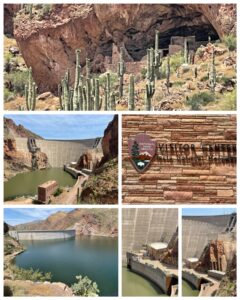 I spent my last tourist day here in Apache Junction going out to the north east to check out a couple national treasures, and a few Roadside oddities. About an hour and a half away, in the middle of the Tonto National Forest, is the Roosevelt Dam. Originally built between 1905 thru 1911, it blocked the Salt River and formed Theodore Roosevelt Lake with its top dam height of 280 feet. The main purpose of the dam was for irrigation, water supply, and flood control. It was renovated and expanded in 1989-1996 due to some deterioration, but also had 77 feet added to it bringing it to a total height of 357 feet. Not exactly the Hoover Dam, but was certainly no less spectacular. Also within the Tonto National Forest is the Tonto National Monument – famed for its Cliff Dwellings. These 13th century habitats were occupied by the Salado culture where they could live free from the excessive heat and monsoon storms, while availing themselves of the nearby Salt River for their agriculture. Pretty cool!
I spent my last tourist day here in Apache Junction going out to the north east to check out a couple national treasures, and a few Roadside oddities. About an hour and a half away, in the middle of the Tonto National Forest, is the Roosevelt Dam. Originally built between 1905 thru 1911, it blocked the Salt River and formed Theodore Roosevelt Lake with its top dam height of 280 feet. The main purpose of the dam was for irrigation, water supply, and flood control. It was renovated and expanded in 1989-1996 due to some deterioration, but also had 77 feet added to it bringing it to a total height of 357 feet. Not exactly the Hoover Dam, but was certainly no less spectacular. Also within the Tonto National Forest is the Tonto National Monument – famed for its Cliff Dwellings. These 13th century habitats were occupied by the Salado culture where they could live free from the excessive heat and monsoon storms, while availing themselves of the nearby Salt River for their agriculture. Pretty cool!
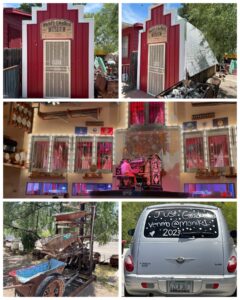 To wrap things up, I did a few more area Roadside visits. One was to the worlds smallest museum – which sadly was closed when I arrived. This 134 square foot shed was the brainchild of Dan Wight and Jake Reaney. The museum reportedly houses such treasures as an old Compaq computer, a Beatles concert poster, and other personal artifacts of the two business partners. The museum is really there to lure people into their Buckboard City Cafe restaurant which stood next door. Now thats marketing! Also visible there was this collection of old wheelbarrows that were strategically placed to form this “Hard Labor Falls”. Too cool! While not listed in Roadside, I found this clever car parked at a gas station while I was filling up. The rear window was painted with a celebratory “Just Graduated 2023” message, but also conveniently included the persons Venmo account – presumably where graduation gifts could be easily deposited. Brilliant! Last up was a visit to a place called Organ Stop Pizza. In addition to having really good pizza, this place has a huge pipe organ. But that’s not all, there are mechanical drums and cymbals on the wall, xylophones hanging from the ceiling, and other musical noise makers throughout. It’s a veritable concert when this really talented guy plays. But you be the judge – here’s a little ditty I captured during his concert.
To wrap things up, I did a few more area Roadside visits. One was to the worlds smallest museum – which sadly was closed when I arrived. This 134 square foot shed was the brainchild of Dan Wight and Jake Reaney. The museum reportedly houses such treasures as an old Compaq computer, a Beatles concert poster, and other personal artifacts of the two business partners. The museum is really there to lure people into their Buckboard City Cafe restaurant which stood next door. Now thats marketing! Also visible there was this collection of old wheelbarrows that were strategically placed to form this “Hard Labor Falls”. Too cool! While not listed in Roadside, I found this clever car parked at a gas station while I was filling up. The rear window was painted with a celebratory “Just Graduated 2023” message, but also conveniently included the persons Venmo account – presumably where graduation gifts could be easily deposited. Brilliant! Last up was a visit to a place called Organ Stop Pizza. In addition to having really good pizza, this place has a huge pipe organ. But that’s not all, there are mechanical drums and cymbals on the wall, xylophones hanging from the ceiling, and other musical noise makers throughout. It’s a veritable concert when this really talented guy plays. But you be the judge – here’s a little ditty I captured during his concert.
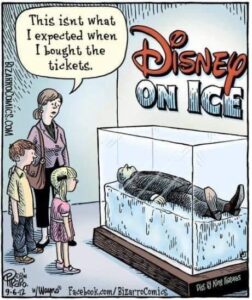 Well, I’ve finally reached the end. Sorry again for this being so darn long. Who would have thunk that I could cram so much stuff into just a two week span. But many of the places I visited during this leg of the trip were especially interesting, and caused me to be a bit verbose in my writings about them. Oh well, I hope you enjoyed it. I’ll spend the next three weeks wrapping up my AZ tour spending a week each in Holbrook, Flagstaff, and Page. During that time I’ll visit a couple national parks, and visit the famous Lake Powell. I did, however, underestimate just how hot it was going to be here in AZ this early in the summer. Already I’ve hit over 100 degrees on several days here. But as they say, it’s a dry heat! Anyway, I hope all of you are enjoying your early summer, and until next time, be well and safe travels.
Well, I’ve finally reached the end. Sorry again for this being so darn long. Who would have thunk that I could cram so much stuff into just a two week span. But many of the places I visited during this leg of the trip were especially interesting, and caused me to be a bit verbose in my writings about them. Oh well, I hope you enjoyed it. I’ll spend the next three weeks wrapping up my AZ tour spending a week each in Holbrook, Flagstaff, and Page. During that time I’ll visit a couple national parks, and visit the famous Lake Powell. I did, however, underestimate just how hot it was going to be here in AZ this early in the summer. Already I’ve hit over 100 degrees on several days here. But as they say, it’s a dry heat! Anyway, I hope all of you are enjoying your early summer, and until next time, be well and safe travels.
I only show a sampling of my adventure pictures here in the blog, and do so mostly in collage format for brevity and ease of reading. If you want to view an album containing individual full fidelity and hi-res images of all my travel pictures related to this specific blog, click the image below. Enjoy!
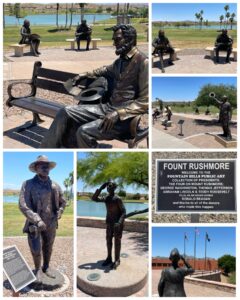

You know, as I was reading about the cryogenics I was thinking I have to ask Bruce if Ted Williams is there and you answered my question. LOL I also heard Walt Disney did the same, but not sure if it is true. Guess that’s what your cartoon at the end refers to?
Great blog again. So interesting. The invisible horse statue also cautious but my eye. You sure find some cool things!!!!
Enjoy your travels
From most of what I read, Walt Disney was in fact cremated and is in Forest Lawn cemetery. But, as the cartoon suggests, the rumor that he was cryogenically preserved lives on. This toon just seemed to fit this particular blog given the subject matter. And, it’s kinda funny at the same time. For sure, there are lots of interesting things out here to see in the country. I just hope I’ve got many more years to find, enjoy, and write about them.
Another interesting blog of all the places you seem to find off the beaten path . The cryonics was creepy but still interesting. I would have loved to see the biosphere, did you get to go inside? I am messaging you a link to the motel girl sign lit up at night that I found that was cool to see. Until the next blog be safe and enjoy your travels.
The tour of Biosphere 2 did in fact include inside. I saw the living areas (kitchen and dining rooms, and working and sleeping quarters) as well as the bios themselves (rainforest, desert, ocean, etc). It was really cool! Follow the link at the bottom of the blog to my Flickr page to see more and better pictures of that visit. Thanks again for the diving girl link.
Way cool Bruce .. enjoy reading these .. the Cryogenics was creepy .. The story I heard as I remember was that Ted Williams wanted to be cremated but his kids did not agree and in Florida (as you remember with Mom’s wishes) children have to agree with the wishes or they will not allowed it to happen.
Absolutely right. There was lots of controversy, lawsuits, and even reports of mishandling by Alcor. The supposed cryonics pact that was signed by Ted and his two kids happened after his will in which he stated then he wanted to be cremated. It was a huge family mess, and the oldest daughter finally gave up fighting due to lack of funds. So who knows for sure if this is what Ted wanted. We will probably never know.
Al and I visited the Titan Museum several years back. I enjoyed seeing the complex and was finally able to visualize what Al would describe to me of his time in the silos. After all it was his career field for the first 9 years of his Air Force service at Little Rock.
Hmmm, I’ve either forgotten or never knew that Al was also stationed at LRAFB and was on the Titan II crew. Good chance we were there at the same time. I do remember that he had worn the Missileman Badge on his uniform, so now that makes sense. We will have to get caught up on this when we get together in Oct. Looking forward to seeing you all then.
Wow. Just Wow . Another great blog. Safe travels. Comfortable 70’s in Western NY with a nice breeze. Paula
. Another great blog. Safe travels. Comfortable 70’s in Western NY with a nice breeze. Paula
Thanks Paula. This leg of the trip sure did have some interesting things to see and write about. Sounds like you are having some great weather there in NY. Enjoy it!
WOW I finally caught up reading all of your blogs. As always, it was wonderful to read them. Love all of the pictures. Just maybe Lee and I will do this one day. Have fun at Grand Canyon. Safe travels.